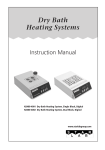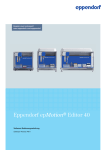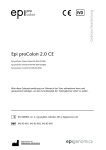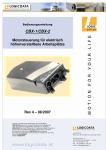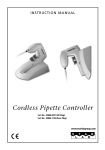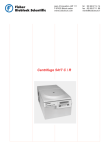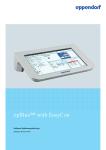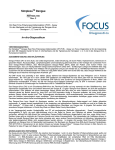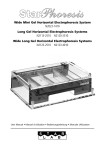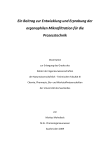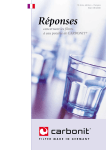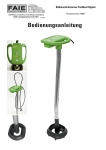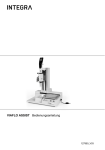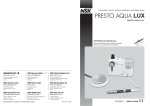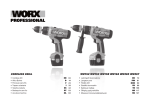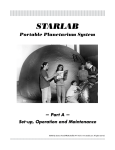Download Microcentrifuge - Genetech Co., Ltd
Transcript
I N S T R U C T I O N MANUAL Microcentrifuge Cat. No N2631-0007 www.starlabgroup.com ENGLISH ......... 1 DEUTSCH ......... 4 FRANÇAISE ...... 7 ITALIANO ....... 10 DECLARATION OF CONFORMITY STARLAB certifies that N2631-0007 Microcentrifuge with 2 Rotors (for Microtubes & PCR Strips) has been manufactured and inspected in accordance with the following International and European standards: 2006/95/EC Low Voltage Directive 2004/108/EC Electromagnetic Compatibility Directive Harmonized Standards: EN 61010-1 Lab Equipment EN 61010-2-020 Lab Equipment, Centrifuges EN 61326-1:2006 Lab Equipment, EMC As an ISO 9001 and ISO 13485 certified company, our working procedures and processes are checked and audited regularly. Additionally, the quality of our products is continously monitored. STARLAB International GmbH ENGLISH STA RL AB M I C R O C E N T R I F U G E Cat. No N2631-0007 General Information The STARLAB Centrifuge is supplied with two rotors; one (standard) for microtubes, and one (strip) for 0.2ml PCR single or strip tubes. The standard rotor is designed to centrifuge up to six individual 1.5/2.0ml plastic microcentrifuge tubes, and will also accept 0.4ml/0.5ml tubes when used with the adapters supplied. The strip tube rotor is designed to centrifuge two 8 x 0.2ml strip tubes and will also accept up to 16 individual 0.2ml tubes. Both rotors are designed for applications requiring relatively low g-forces, such as microfiltration, cell separation and quick spin downs from the walls of tubes. Please read this manual thoroughly before attempting to operate the centrifuge. Warranty The centrifuge and rotor are covered by a one-year warranty which covers the centrifuge and rotor. This warranty is void in the event of incorrect operation, use of non-standard spare parts or accessories, and unauthorised modification of the rotor or centrifuge. The rotor warranty does not cover normal wear and tear, nor does it cover damage and/or weakening caused by radioactive contamination, cleaning agents, or overtightening of the allen screw. Fuses are not covered by the warranty. Exchanging Rotors The rotors are easily exchanged using the allen wrench provided. Locate the set screw on the rotor shaft below the rotor head. Using the wrench, loosen the set screw and pull up the rotor to remove. Place the other rotor into position on the motor shaft. Take care not to press the rotor down so far as to compress the rubber collar at the base of the shaft. Tighten the screw using the allen wrench until finger tight. DO NOT OVERTIGHTEN as this will cause damage to the rotor and the motor shaft. Operation Before operating the centrifuge, be sure that the power switch is in the ON position. To begin a run, simply close the lid of the centrifuge. No other controls are required. To stop rotation, press down on the lid release tab on the front of the unit. This will release the lid lock, and the rotor will slow gradually to a complete stop. CAUTION: Do not attempt to open the lid or remove samples until the unit has come to a complete stop. After the rotor has stopped, the lid may be opened so it sits back on the hinge. 1 Safe operation of the centrifuge requires that the load of the rotor be balanced. Failure to load the rotor properly presents a hazardous condition and may damage the centrifuge. Individual tubes, strip tubes and/or adapters must always be loaded symmetrically to ensure proper balance. Safety Precautions NEVER! • use the centrifuge in any manner not specified in these instructions • operate the centrifuge without a rotor properly attached to the shaft • fill tubes while they are in the rotor. Liquid spillage may harm unit • run the centrifuge with only one strip tube in place • put hands in the rotor area unless the rotor is completely stopped • move the centrifuge while the rotor is spinning • use solvents or flammables near this or other electrical equipment • centrifuge flammable, explosive or corrosive materials • centrifuge hazardous materials outside of a hood or proper containment facility ALWAYS! • load the rotor symmetrically so each tube is counter-balanced by another. The weight of individual tubes must not exceed of 3.0g • locate the centrifuge within easy reach of an electrical outlet • use only plastic microcentrifuge tubes that are designed to withstand centrifugal forces of at least 2,000 xG Cleaning To clean the centrifuge, use a damp cloth and a mild, non-corrosive detergent (pH <8). After cleaning, ensure all parts are dried thoroughly before attempting to operate the unit. Do not immerse the centrifuge in liquid or pour liquids over it. Before using any cleaning or decontamination methods, except those recommended above, check with the manufacturer that the proposed method will not damage the equipment. Customer Services Contact STARLAB or your STARLAB distributor if you have a question about the centrifuge or the unit requires servicing. Please do not send in a unit for service without first obtaining a returns number and a decontamination form. All units returned must be decontaminated and accompanied by a decontamination form. Ensure the unit is properly packed to avoid damage — any damage resulting from improper packaging will be the responsibility of the user. 2 Specifications Dimensions: 150 x 150 x 117mm (approx.) Power: 115V, 60Hz, 130mA or 240V, 50/60Hz, 65mA Fuse: 0.5A, 250V (F) Speed: 6000 RPM RCF: 2000 xG (standard rotor); 1177 xG (strip rotor) The STARLAB microcentrifuge is supplied with: 1 x power cord 2 x rotors (one standard; one strip) 6 x adaptors to convert the standard rotor for use with 0.5ml tubes 1 x wrench for chaning the rotors 3 DEUTSCH STA RL AB M I K R O Z E N T R I F U G E Katalog-Nummer N2631-0007 Allgemeine Informationen Die STARLAB Mikrozentrifuge wird mit zwei Rotoren ausgeliefert. Einem Standard-Rotor für Mikro-Zentrifugengefäße und einem Rotor für 0,2 ml PCR Einzelgefäße oder Gefäßstreifen. Der Standard-Rotor hat eine Aufnahmekapazität von bis zu sechs Mikrozentrifugengefäßen 1,5/2,0 ml. Bei Benutzung des mitgelieferten Adapters ist auch die Verwendung von 0,4/0,5 ml Gefäßen möglich. Der Rotor für Gefäßstreifen hat eine Aufnahmekapazität von zwei 0,2 ml 8er PCR-Gefäßstreifen oder alternativ von bis zu 16 individuellen 0,2 ml PCR-Einzelgefäßen. Beide Rotoren wurden für Anwendungen entwickelt, für die nur relativ geringe Zentrifugalkräfte erforderlich sind, wie zum Beispiel zur Mikrofiltration, der Zelltrennung oder dem schnellen Anzentrifugieren. Bitte lesen Sie die Anleitung vor der Benutzung des Gerätes sorgfältig. Garantie Auf die Zentrifuge sowie die mitgelieferten Rotoren wird eine Garantie von einem Jahr gewährt. Die Garantie verfällt bei Verwendung unzulässiger Ersatzteile, bei unzulässigen Eingriffen oder bei unsachgemäßer Bedienung des Rotors oder der Zentrifuge. Die Garantie des Rotors entfällt bei normalen Abnutzungserscheinungen, Schäden durch radioaktive Kontamination, Reinigungsmittel oder durch das Überdrehen der Feststellschraube. Sicherungen sind ebenfalls von der Garantie ausgeschlossen. Austausch des Rotors Der Rotor lässt sich mit Hilfe des mitgelieferten Inbusschlüssels einfach auswechseln. Suchen Sie die Feststellschraube am Rotorschaft unter dem Rotorkopf. Lösen Sie die Feststellschraube mit Hilfe des Inbusschlüssels, ziehen Sie den Rotor von der Rotorwelle und positionieren Sie den neuen Rotor auf der Rotorwelle. Achten Sie darauf, den Rotor nicht zu weit auf die Rotorwelle zu drücken, um die Gummimanschette an der Basis des Schaftes nicht zu quetschen. Ziehen Sie die Feststellschraube mit dem Inbusschlüssel wieder fest. Vorsicht: Das ÜBERDREHEN DER FESTSTELLSCHRAUBE führt zu Schäden am Rotor und am Rotorschaft. 4 Bedienung Bevor Sie die Zentrifuge in Betrieb nehmen, stellen Sie sicher, dass der Netzschalter in der ONPosition steht. Um einen Durchlauf zu starten, schließen Sie den Deckel der Zentrifuge. Weitere Schritte sind nicht notwendig. Um die Zentrifuge anzuhalten, drücken Sie den Hebel der Deckelverriegelung an der Vorderseite des Gerätes. Das Gerät fährt allmählich herunter bis zum kompletten Halt. Vorsicht: Versuchen Sie nicht den Deckel zu öffnen oder Probengefäße aus der Zentrifuge zu entnehmen, bis das Gerät vollständig still steht. Nach Anhalten des Rotors sollte der Deckel vollständig zurückgeklappt werden. Für den sicheren Betrieb der Zentrifuge ist der Rotor gleichmäßig zu beladen. Unsachgemäßes Beladen der Zentrifuge kann Schäden am Gerät verursachen. Einzelgefäße, Gefäßstreifen und/ oder Adapter sind symmetrisch anzuordnen, um ein einwandfreies Zentrifugieren zu gewährleisten. Sicherheitshinweise Niemals! • das Gerät anderweitig als in dieser Bedienungsanleitung beschrieben benutzen. • das Gerät mit einem nicht ordnungsgemäß an der Rotorwelle befestigten Rotor bedienen. • Probengefäße im Gerät befüllen. Verschüttete Flüssigkeit kann das Gerät beschädigen. • das Gerät mit nur einem Gefäß bedienen. • die Hände im Bereich des Rotors halten, bevor das Gerät vollständig still steht. • das Gerät während des laufenden Betriebes bewegen. • Lösungsmittel oder entflammbare Flüssigkeiten in der Nähe des Gerätes oder anderen elektrischen Geräten benutzen. • brennbare, explosive oder ätzende Flüssigkeiten zentrifugieren. • gefährliche Materialien außerhalb eines Abzuges oder eines geeigneten Sicherheitsbereiches zentrifugieren. Immer! • den Rotor gleichmäßig beladen. Das Gewicht je Gefäß darf 3 g nicht überschreiten. • die Zentrifuge möglichst in der Nähe der Steckdose aufstellen. • ausschließlich Kunststoffgefäße benutzen, die für Zentrifugalkräfte von mindestens 2,000 x G ausgelegt sind. 5 Reinigung Benutzen Sie für die Reinigung des Gerätes ein feuchtes Tuch und ein mildes, nicht ätzendes Detergens (pH<8). Nach der Reinigung stellen Sie sicher, dass alle Teile sorgfältig getrocknet sind, bevor Sie das Gerät wieder in Betrieb nehmen. Tauchen Sie das Gerät nicht in Flüssigkeiten oder überführen Sie Flüssigkeiten nicht über dem Gerät. Bevor Sie eine Reinigungs- oder Dekontaminationsmethode anwenden, die von den oben aufgeführten abweicht, vergewissern Sie sich beim Hersteller, dass die vorgeschlagene Methode das Gerät nicht beschädigt. Kundenservice Haben Sie Fragen zur Zentrifuge oder zu unserem Service, kontaktieren Sie STARLAB oder Ihren STARLAB Händler. Bitte beachten Sie: Alle Warenrücksendungen müssen grundsätzlich dekontaminiert sein. Der Nachweis über die Dekontamination ist über eine der Rücksendung beigefügte schriftliche Erklärung zu bestätigen. Um Transportschäden zu vermeiden, stellen Sie die ordnungsgemäße Verpackung des Geräts sicher. Für Schäden am Gerät, die auf unsachgemäßes Verpacken zurückzuführen sind, trägt der Rücksender die Verantwortung. Technische Daten Abmaße: 150 x 150 x 117 mm (ca. Angaben) Leistung: 115 V, 60 Hz, 130 mA oder 240 V, 50/60 Hz, 65 mA Sicherung: 0,5 A, 250 V (F) Drehzahl: 6000 U/min Zentrifugalkraft: 2000 x G (Standard-Rotor), 1177 x G (Rotor für Gefäßstreifen) Die STARLAB Mikrozentrifuge wird ausgeliefert mit: 1 Netzkabel 2 Rotoren ( 1 x Standard, 1 x für PCR-Gefäßstreifen) 6 Adapter zum Umbau für die Verwendung von 0,5 ml Gefäßen 1 Inbusschlüssel zum Wechsel der Rotoren 6 FRANÇAIS MIC RO CENTR I F U G E U S E S TA R L AB Katalog-Nummer N2631-0007 Information générale La centrifugeuse STARLAB est fournie avec deux rotors: un (standard) pour les microtubes, et un autre pour les tubes ou barrettes de tubes 0.2ml. Le rotor standard peut centrifuger jusqu’à six microtubes de 1.5/2.0ml, mais des tubes de 0.4ml/0.5ml peuvent être utilisés grâce à l’adaptateur fourni. Le rotor pour barrettes peut contenir deux barrettes de 8 tubes PCR 0.2ml ou 16 tubes individuels de 0.2ml. Ces deux rotors sont faits pour des applications ne nécessitant pas une vitesse élevée comme la microfiltration, les séparations de cellules ou centrifugation rapide. Lisez ce manuel attentivement avant d’utiliser cette microcentrifugeuse. Garantie La centrifugeuse et les rotors sont garantis un an. Cette garantie cesse en cas de mauvaise utilisation de l’appareil, d’utilisation de pièces détachées ou d’accessoires non-standards, ou de modifications non autorisées de la centrifugeuse ou des rotors. La garantie ne couvre pas l’usure normale du rotor ou tout dommage causé par une exposition aux radiations, aux détergents ou un vissage excessif. Les fusibles ne sont pas couverts par la garantie. Changement de rotors Les rotors se changent facilement en utilisant la clé allène fournie. Repérez la vis située à la base du rotor. Desserrez la vis avec la clé et retirez le rotor. Placez l’autre rotor au dessus de la tige du moteur. Ne pas appuyer trop fortement le rotor sur le moteur de manière à ne pas écraser la partie en caoutchouc. Serrez la vis avec la clé. NE PAS TROP SERRER ce qui pourrait endommager le rotor et le moteur. Utilisation Avant d’utiliser la centrifugeuse, vérifier que le bouton d’alimentation est sur la position ON. Pour commencer une centrifugation, fermez le couvercle. Il n’y a pas d’autres réglages nécessaires. Pour stopper la centrifugeuse, abaissez la languette située à la base du couvercle. Ceci déverrouillera le couvercle, et le rotor ralentira progressivement. ATTENTION: Ne pas essayer d’ouvrir le couvercle ou de retirer les tubes avant l’arrêt complet de l’appareil. Une fois le rotor stoppé, le couvercle peut être ouvert jusqu’à la butée. Toute centrifugation nécessite que le rotor soit équilibré. Tout déséquilibre dans le chargement du rotor peut être dangereux et 7 endommager l’appareil. Les tubes individuels, les barrettes et/ou les adaptateurs doivent toujours être placés de manière symétrique dans le rotor afin d’assurer un bon équilibre. Précautions d’usage NE JAMAIS! • utiliser l’appareil d’une autre manière que celle décrite dans ce manuel • faire fonctionner la centrifugeuse sans que le rotor ne soit fixé au moteur • remplir les tubes quand ils sont déjà dans le rotor, ceci pourrait abimer l’appareil en cas de contact avec des liquides • utiliser la centrifugeuse avec une seule barrette de tubes • toucher le rotor avant son arrêt complet • déplacer l’appareil pendant son fonctionnement • utiliser des solvants ou des produits inflammables proches de cet appareil ou de tout autre appareil électrique • centrifuger des produits inflammables, explosifs ou corrosifs • centrifuger des produits dangereux à l’extérieur d’une hotte TOUJOURS! • charger le rotor de manière symétrique pour qu’il soit équilibré. Le poids de chaque tube ne doit pas dépasser 3.0g. • placer la centrifugeuse proche d’une prise de courant • utiliser uniquement des microtubes en plastique pouvant supportant au moins 2,000 xG Nettoyage Pour nettoyer la centrifugeuse, utiliser un tissu humide et un détergent doux, non corrosif (pH <8). Vérifiez que toutes les parties sont bien sèches avant d’utiliser à nouveau l’appareil. Ne pas immerger l’appareil ou renverser de liquides sur celui-ci. Contacter le fabricant, avant d’utiliser toute méthode de décontamination ou détergents différents de ceux indiqués dans ce manuel, pour vérifier que cela n’endommagera pas l’appareil. Service Après-vente Contactez STARLAB ou votre distributeur STARLAB si vous avez des questions sur cette centrifugeuse et/ou ses réparations. Ne pas retourner l’appareil sans avoir obtenu un numéro de retour et une fiche de décontamination. Toutes les centrifugeuses doivent être décontaminées et accompagnées d’une fiche de décontamination. Il convient à l’utilisateur de retourner l’appareil dans de bonnes conditions d’emballage, tout dommage résultant d’un mauvais emballage lors du retour sera de la responsabilité de l’utilisateur. 8 Spécifications Dimensions: 150 x 150 x 117mm (approx.) Alimentation: 115V, 60Hz, 130mA or 240V, 50/60Hz, 65mA Fusible: 0.5A, 250V (F) Vitesse: 6000 tour/min RCF: 2000 xG (rotor standard); 1177 xG (rotor pour barrettes) La microcentrifugeuse STARLAB est fournie avec: 1 cordon d’alimentation 2 rotors (un standard et un pour barrettes) 6 adaptateurs pour tubes 0.5ml 1 clé allen pour changer les rotors 9 ITALIANO MIC RO CENTR I F U G A S TA R L A B Codice N2631-0007 Informazioni generali La centrifuga STARLAB viene fornita con due rotori; uno (standard) per microprovette, e uno (strip) per provette per PCR da 0.2ml singole o in strip. Il rotore standard è adatto a centrifugare fino a 6 provette per microcentrifuga da 1.5/2.0ml, e accetta anche provette da 0.4ml/0.5ml se utilizzato con l’adattatore fornito. Il rotore per provette in strip è adatto a strip da 8 provette da 0.2ml e accetta anche fino a 16 provette da 0.2ml. Entrambi i rotori sono adatti ad applicazioni richiedenti una forza g relativamente bassa, come microfiltrazioni, separazioni cellulari e distacco rapido dalle pareti delle provette . Leggere attentamente questo manuale prima di utilizzare la centrifuga. Garanzia La centrifuga ed il rotore sono coperti da garanzia annuale che comprende la microcentrifuga ed il rotore. Questa garanzia non è valida in caso di utilizzo non corretto, uso di pezzi di ricambio o accessori non standard, e modifiche non autorizzate del rotore o della centrifuga. La garanzia del rotore non copre la normale usura, non copre il danno o l’indenbolimento dovuto a contaminazione radioattive, agenti sgrassanti, o eccessivo avvitamento di tutte le viti. I fusibili non sono coperti da garanzia. Cambiamento dei rotori II rotori sono facilmente cambiabili tramite la chiave fornita. Posizionare la vite di arresto nell’albero del rotore sotto la testa dello stesso. Tramite la chiave, allentare la vite di arresto e sollevare il rotore e rimuoverlo. Disporre l’altro rotore nell’albero. Fare attenzione a non comprimere il rotore fino all’anello di gomma del rotore. Stringere bene la vite usando la chiave fino alla barretta. NON STRINGERE ECCESSIVAMENTE poichè si potrebbe danneggiare il rotore e l’albero del motore. 10 Funzionamento Prima di utilizzare la centrifuga, assicurarsi che il tasto d’accensione sia su ON. Per iniziare la corsa, chiudere il coperchio della centrifuga. Non sono richiesti altri controlli. Per terminare la rotazione, premere la linguetta del coperchio posta nella parte anteriore dello strumento. Ciò allenterà il coperchio e la rotazione terminerà gradualmente. ATTENZIONE: Non tentare di aprire il coperchio o di rimuovere i campioni fino a che lo strumento non si è arrestato. Dopo che il rotore si é arrestato, il coperchio può essere aperto e resterà attaccato al perno. Il funzionamento sicuro della centrifuga richiede che il carico del rotore sia bilanciato. Un errato caricamento del rotore rappresenta una condizione di rischio e la centrifuga potrebbe essere danneggiata. Provette singole, in strip e/o gli adattatori devono essere sempre caricati simmetricamente per assicurare l’equilibrio adeguato. Precauzioni MAI! • usare la centrifuga diversamente da quanto specificato su queste istruzioni • utilizzare la centrifuga senza un rotore attaccato adeguantamente all’albero • riempire le provette già nel rotore. Il versamento di liquido potrebbe danneggiare l’unità • far funzionare la centrifuga con solo una strip di provette • inserire le mani nell’area rotore fino a che questo non è completamente fermo • spostare la centrifuga mentre il rotore è in azione • usare solventi o materiali infiammabili vicino allo strumento • centrifugare materiali infiammabili esplosivi o corrosivi • centrifugare materiali rischiosi SEMPRE! • caricare il rotore simmetricamente cosicchè ogni provetta sia controbilanciata da un’altra. Il peso di ogni provetta non deve eccedere i 3.0g • posizionare la centrifuga vicino ad una presa della corrente elettrica • utilizzare solo provette per microcentrifuga di plastica destinate a sopportare una forza centrifuga di almeno 2,000 xG 11 Pulizia Per pulire la centrifuga utilizzare un panno umido e un detersivo delicato e non corrosivo (pH <8). Dopo la pulizia assicurarsi che tutte le parti siano asciutte prima di utilizzare lo strumento. Non immergere la centrifuga in liquidi e non far traboccare liquidi. Prima di utilizzare metodi di pulizia o decontaminazione, ad eccezioni di quelli sopra descritti, chiedere al produttore se il metodo prescelto non danneggerà lo strumento. Servizio Consumatori Contattare STARLAB o il Vostro funzionario STARLAB per qualsiasi domanda riguardante la centrifuga. Non inviare l’unità per riparazione prima di aver ottenuto un numero e un modulo per la decontaminazione. Tutte le unità restituite dovranno essere accompagnate da un modulo di decontaminazione. Assicurarsi che l’unità sia ben imballata per evitare danneggiamenti – qualsiasi danneggiamento è sotto la responsabilità dell’utilizzatore Caratteristiche Dimensioni: 150 x 150 x 117mm (approx.) Potenza: 115V, 60Hz, 130mA or 240V, 50/60Hz, 65mA Fusibile: 0.5A, 250V (F) Velocità: 6000 RPM RCF: 2000 xG (rotore standard ); 1177 xG (rotore per strip) La microcentrigufa viene fornita con: 1 x cavo di alimentazione 2 x rotori (uno standard; uno per strip) 6 x adattatori per convertire il rotore standard per usi con provette da 0.5ml 1 x chiave per sostituire i rotori 12 NOTES 13 STARLAB International GmbH Neuer Höltigbaum 38 22143 Hamburg Germany Tel: +49 (0)40 675 99 39 0 Fax: +49 (0)40 675 99 39 20 [email protected] STARLAB GmbH Neuer Höltigbaum 38 22143 Hamburg Germany Tel: +49 (0)40 675 99 39 0 Fax: +49 (0)40 675 99 39 20 [email protected] STARLAB (UK), Ltd 4 Tanners Drive Milton Keynes MK14 5NA United Kingdom Tel: +44 (0)1908 283800 Fax: +44 (0)1908 283802 [email protected] STARLAB FRANCE SARL 38 Avenue Henri Barbusse 92220 Bagneux France Tel: +33 (0)1 45 3652 80 Fax: +33 (0)1 45 3604 86 [email protected] STARLAB S.r.l. Via Corelli 36/5 20134 Milano Italy www.starlabgroup.com Tel: +39 (0)2 7020 1040 Fax: +39 (0)2 7020 1033 [email protected] V2. 02/2012
















